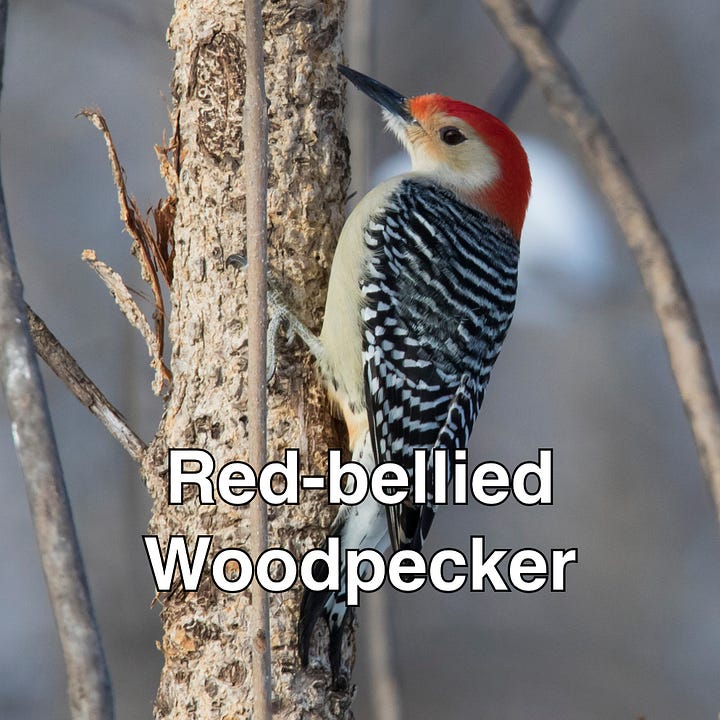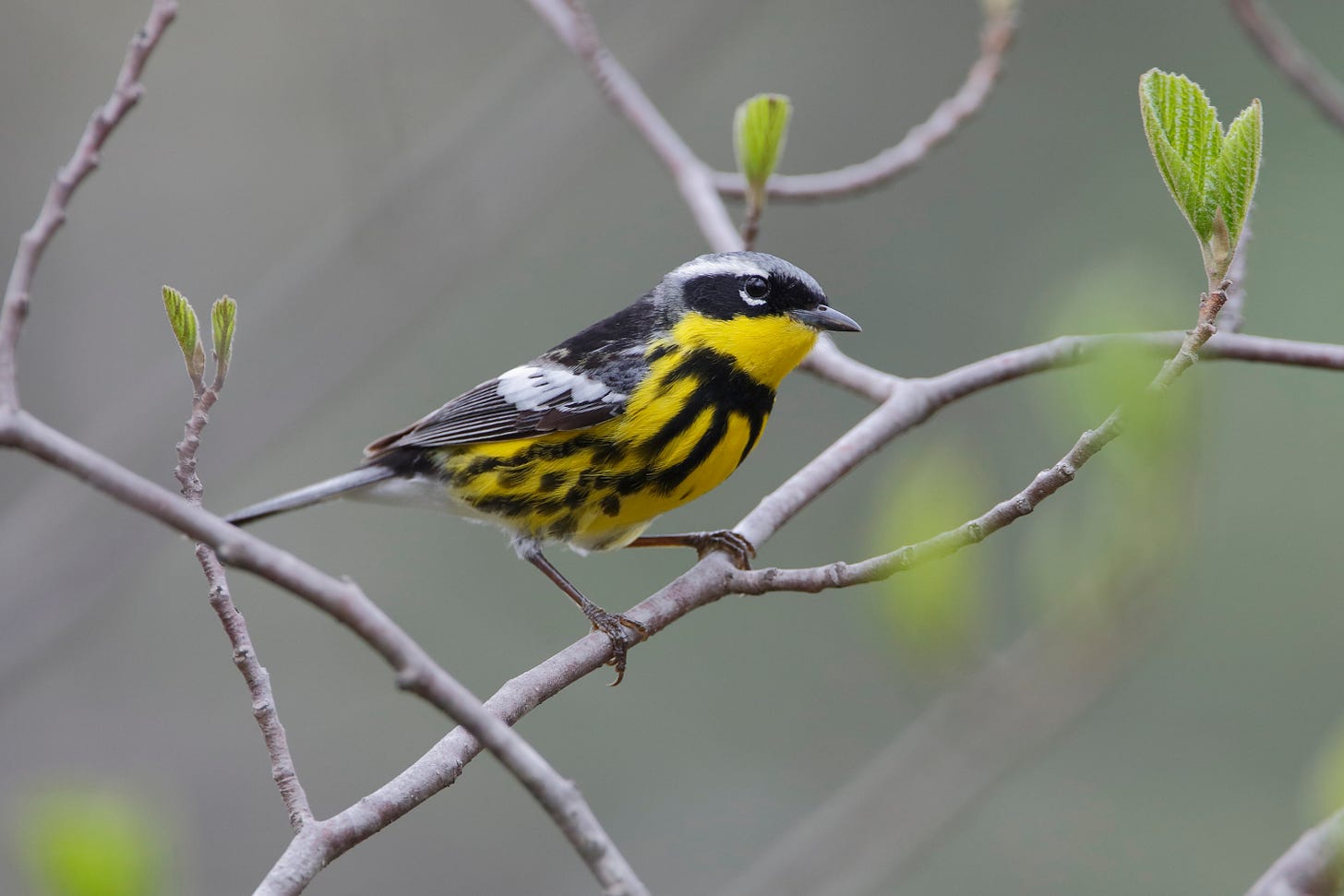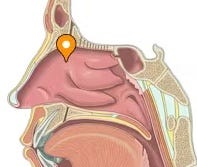Unlike the slavish quarters of labor time made up by corporate humanoids, micro-seasons are straight from source, the great unity, the god-babe herself: Mama Natura. Current Japanese micro-season (out of 72!): Frogs start singing & Worms surface. As for McGolrick Park, perhaps New York City and even larger swathes of the eastern US, we notice—
MICRO-SEASONINGS
Alliums bloom • Crows battle for territory • Hawthorn trees pop • First American Redstarts, Blackpoll, Chestnut-sided and Blackburnian Warblers • Wood Thrushes sing • Wrens emerge • Northern Waterthrush returns • First Cuckoo • Falling particles fly into mouths and cause nasopharyngeal havoc
Did we miss anything? We’ll declare this micro-season’s “official” name at year’s end.
Ever wonder what tree you’re staring at? Check out NYC Parks’ insanely good tree map
Two species of crows reside in New York City—American and Fish Crows. Fishies caw as if they’re sinus infected. They also say “uh uh.” As in: Are you an American Crow? “Uh uh.”
Three species of wrens reside in New York City—Carolina, House and Winter Wrens. Try to note these tiny birds’ subtly different plumages
Cuckoo!? Yeah, hot stuff. Two species are findable in New York City during migration—the Black-billed and Yellow-billed Cuckoos. Wild af, we know. Shoutout P-Slay for the black-billed spot <3
MAY 11, 2024 — SATURDAY
Conditions: Perfect • Attendance: 152 at peak 👋😄 • Vibrations: Great-crested
Saturday birds: Rose-breasted Grosbeak · Great Crested Flycatcher · Northern Parula · Common Yellowthroat · Ovenbird · Common Grackle · Ruby-crowned Kinglet · American Redstart · Northern Cardinal · American Crow · Chimney Swift · American Kestrel · White-throated Sparrow · Blue Jay · Laughing Gull (flyover) … And the virtually always present in urban parks like McGolrick: Rock Pigeon, European Starling, American Robin, House Sparrow, Mourning Dove. Learn these last 5 and you’ll be set to notice less common birds.
Pic of the day:
MICRO-LESSON: EASTERN WOODPECKERS
In McGolrick Park there are four woodpeckers with whom we go h-h-a-a-r-r-d-d.
To be more specific, at any time of the year one shouldn’t be able to walk NYC parks like McGolrick without noticing at least one of these pretties:




Downy Woodpecker: McGolrick’s most common woodpecker is also the US’s smallest. Apparently named for the white—soft-looking?—stripe that runs down their middle backs. These babes make squeaky-toy calls, including a descending trill that one hottie quipped goes downy-ward! Clever lot, y’all be.
Red-bellied woodpecker: Red mohawks and studded leather jackets. These 1980’s punks historically leave McGolrick in late May before returning in October. But their hardcore lüks, ch-ch-chs and churl calls can be noticed in bigger NYC parks year-round. Why red-bellied when all you see is an off-white tum-tum? Get up-close, like folks who named bird specimens did, to notice red smatterings.
Yellow-bellied Sapsuckers: Another woody—yes sapsuckers are woodies—who’ll soon summer break from McGolrick, but not NYC’s bigger parks. Sapsuckies do in fact suck sap, along with any bugs surfing the stuff. Yellow-bellies have a dingy look, and can easily be ID’d by their bright white side-stripes. Females and young males look like the pictured breeding male but sans colors, and dingier. Also pictured: sapsuckers leave neat rows of holes in the trees they tap.
Northern Flickers: I mean at this point y’all are Northern Flicker factoid machines, right? Black pendant necklace, Yayoi Kusama approved spots, keer call, east of the rockies: yellow feathers, west of ‘em: pink, “monkey call”, lovers of ants—both for food and formic acid bathing, McGolrick Park breeder and subsequent object of our pagan devotion. Reader, wherever you are in the US, go outside and notice a mother-flicking Northern Flicker RIGHT NOW.
There are two other woodpecker species common to the eastern United States: the Red-headed and Hairy Woodpeckers. Though the Hairy is common in NYC’s bigger parks, they rarely if at all visit McGolrick. Red-heads are uncommon citywide, preferring environs a bit further south and west of NYC, but do on rare occasion visit
One of the first lessons new birders encounter is the famous Hairy vs. Downy Woodpecker debacle. The species look exactly the same except A) Hairies are bigger B) Hairies have longer bills, about the same width as their skulls C) Hairies’ squeak-toy calls don’t descend
Browse all 23 woodpecker species findable in the United States here
ON NOTICE
Magnolia Warbler

Magnolia Warblers have just begun appearing in McGolrick Park/NYC. They’re so beautiful that David Allen Sibley—ornithologist and illustrator of the holy text Sibley Guide to Birds, slapped one on its cover. NB: You should own that book!
How do we know these masked hotties are coming? Short answer: data. Long answer: Most US and international parks are findable on eBird, Cornell University’s canonical bird database, as “hotspots.” Each hotspot features a tool called “Bar Charts.” Click that link on any hotspot’s page—check the left nav—and you’ll see likelihood charts for every bird ever seen in situ. The charts are based on historical data generated by actual birders. So McGolrick’s charts are majority powered by us!
How to find Magnolias? You already know! 1. Go to a park with your senses turned up such that, entranced, you truly inhabit the stinky, intelligent, hunter/gatherer animal body to which you were born 2. Pause near high-vibration trees and bushes and water sources 3. Let unfamiliar sounds direct your attention 4. Visually pat down leaves with a soft focus to detect small movements 5. Find a visual feature near the movement, usually a particularly shaped branch that you feel will pop at zoom-in 6. Lift your binoculars and dance with the bird, Magnolia Warbler or no <3
McGolrick’s hotspot page is here
McGolrick’s frequency charts are here
Check our NYC’s most common 22 warblers reel for a grand refresh
UPDATES, ANNOUNCEMENTS, REQS
LASTLYS
- Maestro Jack Salyers is showing at the International Center of Photography on May 17th. Bring your binoculars to the show 😀—get tix here
- We don’t identify as sciencey, but birds do make us sci-curious. Same? it might be time to experiment—
Check out this upcoming NYC event:
Cactus Store/Nonhuman Teachers’ May 22nd HORT/CULTURE, where
Jared Margulies will give a multimedia presentation on his 2023 book The Cactus Hunters, which explores the illegal trade in succulents, and the passion that drives it
Corey Fogel will perform John Cage's seminal 1976 piece Branches, which calls for the use of amplified seed pods, cacti, and other plant materials selected by the performer(s)
Read this article about re-wilding your urban yard
Then get to know Joey Santore & Doug Tallamy without delay
Then read this timely Times piece that seeks yardly compromise
- We’re doing another near-flung Sunday Walk:
5/19 - Brooklyn Bridge Park — meet here, 9am · Just show up
- We just sent another 40% off bulk order over to our friends at Nocs Provisions. It includes 4 new, unclaimed Field Issue 8x32 binoculars that we figured folks who missed the discount might dig. Hit us up and we’ll arrange an in-person exchange





